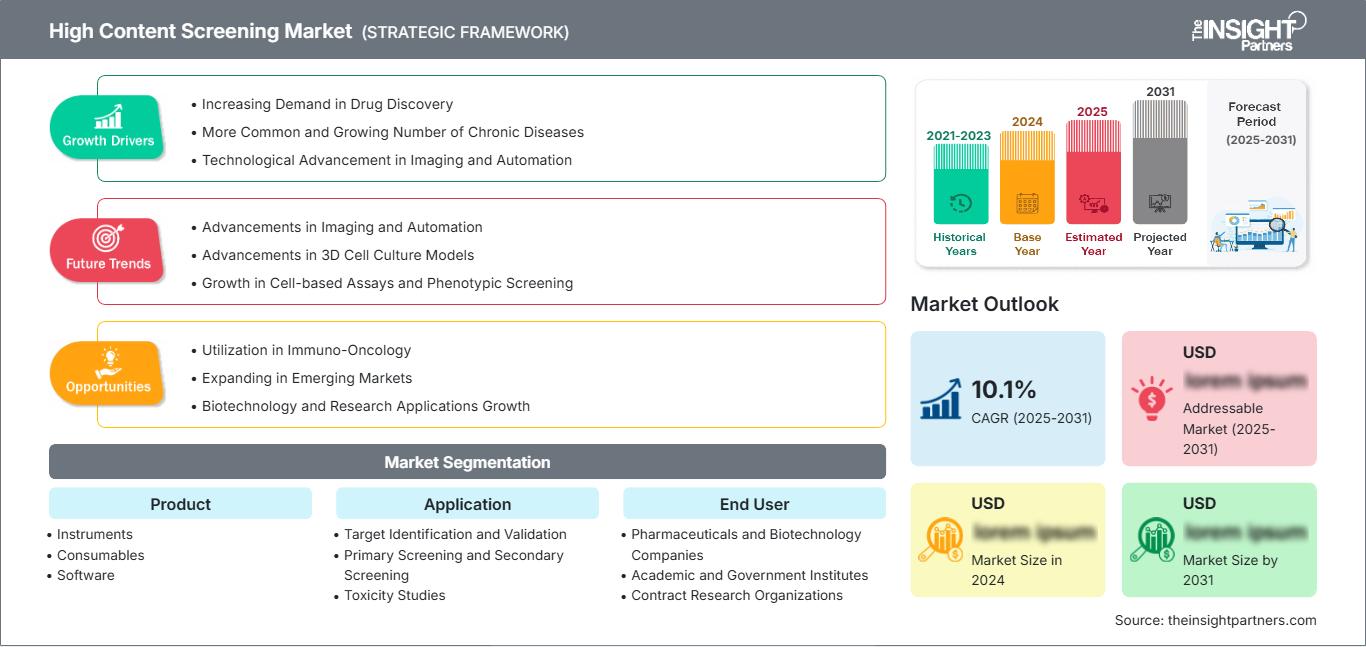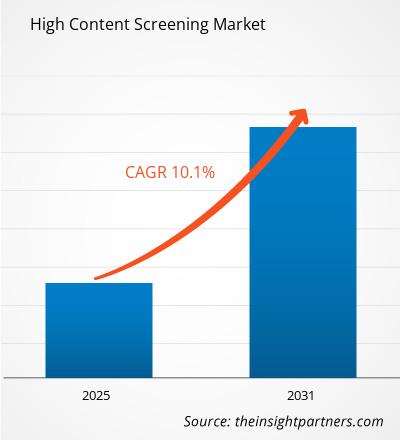ハイコンテントスクリーニング市場は、2031年までに29億3,000万米ドルに達すると予想されています。市場は2025年から2031年にかけて6.6%のCAGR(年平均成長率)で成長すると見込まれています。
ハイコンテントスクリーニング市場は、製品別に機器、消耗品、ソフトウェア、サービス、アクセサリに分類されています。さらに、ターゲットの特定と検証、一次スクリーニングと二次スクリーニング、毒性試験、化合物、その他といった用途、そして製薬会社やバイオテクノロジー企業、学術機関や政府機関、受託研究機関(CRO)といったエンドユーザー別にも細分化されています。2031年までの予測は、ハイコンテントスクリーニング市場の成長が生産性と顧客満足度にどのような影響を与えるかについて貴重な洞察を提供します。グローバル分析は、地域レベルと主要国別に細分化されています。上記のセグメント分析では、市場評価は米ドルで提示されています。
レポートの目的
The Insight Partners のレポート「ハイコンテンツ スクリーニング市場」は、現在の状況と将来の成長、主な推進要因、課題、機会について説明することを目的としています。これにより、次のようなさまざまなビジネス ステークホルダーに洞察が提供されます。
- 技術プロバイダー/メーカー: 進化する市場動向を理解し、潜在的な成長機会を把握することで、情報に基づいた戦略的決定を下すことができます。
- 投資家: 市場の成長率、市場の財務予測、バリュー チェーン全体に存在する機会に関する包括的なトレンド分析を実施します。
- 規制機関: 市場の乱用を最小限に抑え、投資家の信頼と信用を維持し、市場の完全性と安定性を維持することを目的として、市場における政策と警察活動を規制します。
ハイコンテントスクリーニング市場セグメンテーション製品
- 機器
- 消耗品
- ソフトウェア
- サービス
- アクセサリー
アプリケーション
- ターゲットの特定と検証
- 一次スクリーニングと二次スクリーニング
- 毒性試験
- 化合物
エンドユーザー
- 製薬会社およびバイオテクノロジー企業
- 学術機関および政府機関
- 契約研究機関
地域
- 北米
- ヨーロッパ
- アジア太平洋地域
- 南米および中米
- 中東およびアフリカ
レポートの一部、国レベルの分析、Excelデータパックなどを含め、スタートアップ&大学向けに特別オファーや割引もご利用いただけます(無償)
ハイコンテントスクリーニング市場: 戦略的洞察

- このレポートの主要な市場動向を入手してください。この無料サンプルには、市場動向から見積もりや予測に至るまでのデータ分析が含まれます。
ハイコンテントスクリーニング市場の成長ドライバー
- 創薬における需要の増加:ハイコンテントスクリーニング(HCS)は、医薬品の研究開発に必須の技術です。ますますグローバル化が進む製薬業界では、新薬候補をより効率的にスクリーニングする方法が模索されており、何千もの化合物をスクリーニングし、細胞への影響を確かめるために HCS システムの使用が増えています。
- 慢性疾患のより一般的化と増加:慢性疾患(がん、糖尿病、神経変性疾患など)の数は増加しており、医薬品開発と精密医療のためのスクリーニング技術の使用がさらに必要になっています。これが、生物医学研究と臨床診療におけるハイコンテントスクリーニングを促進しています。
- イメージングと自動化における技術の進歩:自動顕微鏡検査、3Dイメージング、AI駆動型画像分析など、イメージング技術は大きく進歩しました。これらはHCSプロセスに変化をもたらし、細胞応答のスループット、精度、解像度の向上を可能にしています。このような改善により、大規模な化合物ライブラリをより高速かつ高精度にスクリーニングできるため、あらゆる種類の研究および臨床アプリケーションでHCSの使用が促進されています。
ハイコンテントスクリーニング市場の将来の動向
- イメージングと自動化の進歩:自動イメージング、マイクロプレートリーダー、データ分析の自動化により、ハイコンテントスクリーニングソリューションの精度とスループットが向上しました。自動化されたHCSシステムは、活性化合物の検出に一貫性と効率性をもたらし、市場を牽引しています。
- 3D細胞培養モデルの進歩:現在、HCSで3D細胞培養システムを使用する傾向があります。これらのシステムにより、従来の2D培養よりも生理学的に適切な環境で薬物試験を行うことができます。これらの培養は複雑なヒト組織をより適切に表現しており、それが薬物スクリーニングの結果に反映されています。この需要の増加により、3D細胞培養システムをサポートする高度なHCSプラットフォームの巨大な市場が創出され、市場成長の原動力となっています。
- 細胞ベースアッセイと表現型スクリーニングの成長:より関連性の高い生物学的情報を提供するため、従来の生化学アッセイよりも細胞ベースアッセイが好まれるようになっています。特に表現型スクリーニングは、分子標的に関する先入観なしに化合物が細胞表現型に及ぼす影響を特定できるため、人気が高まっています。この傾向により、新薬候補の特定や疾患モデルの改良におけるHCSの有用性が高まっています。
ハイコンテントスクリーニングの市場機会
- 免疫腫瘍学における利用:ハイコンテントスクリーニングは、新しいがん免疫療法を見つけるために、免疫腫瘍学で採用が広がっています。この新しい研究分野は、がん治療を促進する免疫調節薬のスクリーニングのためのHCS技術にとって重要なプラットフォームとなる可能性があります。
- 新興市場への拡大:精密医療の世界的なニーズが高まる中、新興市場はハイコンテントスクリーニング技術の拡大にとって大きな成長機会を提供しています。これらの地域の医療インフラと研究施設が成長するにつれて、導入が加速する可能性があります。
- バイオテクノロジーと研究アプリケーションの成長:HCSは、特にがん研究、幹細胞研究、遺伝子研究において、学術研究およびバイオテクノロジー分野で急速に増加しています。複雑な生物学的現象を分析し、高次元データを提供するHCSシステムの能力は、細胞反応、遺伝子発現、疾患メカニズムの理解に役立ち、高度な研究とイノベーションに取り組む研究機関、バイオテクノロジー企業、および契約研究機関においてHCSが活用できる余地を生み出しています。
ハイコンテンツスクリーニング市場
ハイコンテントスクリーニング市場における予測期間全体にわたる地域的な動向と要因については、The Insight Partnersのアナリストが詳細に解説しています。また、このセクションでは、北米、ヨーロッパ、アジア太平洋、中東・アフリカ、中南米における心不整脈疾患管理市場のセグメントと地域についても解説しています。
ハイコンテンツスクリーニング市場レポートの範囲
| レポート属性 | 詳細 |
|---|---|
| の市場規模 2024 | US$ XX Billion |
| 市場規模別 2031 | US$ 2.93 Billion |
| 世界的なCAGR (2025 - 2031) | 6.6% |
| 過去データ | 2021-2023 |
| 予測期間 | 2025-2031 |
| 対象セグメント |
By 製品
|
| 対象地域と国 | 北米
|
| 市場リーダーと主要企業の概要 |
|
ハイコンテンツスクリーニング市場のプレーヤー密度:ビジネスダイナミクスへの影響を理解する
ハイコンテントスクリーニング市場は、消費者の嗜好の変化、技術の進歩、製品の利点に対する認知度の高まりといった要因によるエンドユーザーの需要増加に牽引され、急速に成長しています。需要の増加に伴い、企業は製品ラインナップの拡充、消費者ニーズへの対応のためのイノベーション、そして新たなトレンドの活用を進めており、これが市場の成長をさらに加速させています。

- 入手 ハイコンテントスクリーニング市場 主要プレーヤーの概要
主なセールスポイント
- 包括的なカバレッジ:本レポートは、ハイコンテントスクリーニング市場の製品、サービス、タイプ、エンドユーザーの分析を包括的に網羅し、包括的な展望を提供しています。
- 専門家による分析:本レポートは、業界の専門家とアナリストの深い理解に基づいて作成されています。
- 最新情報:本レポートは、最新の情報とデータトレンドを網羅しているため、ビジネスの関連性を保証します。
- カスタマイズオプション:本レポートは、特定のクライアントの要件に対応し、ビジネス戦略に適切に適合するようにカスタマイズできます。
したがって、ハイコンテントスクリーニング市場に関する調査レポートは、業界のシナリオと成長の見通しを解読し理解するための先導役となります。いくつかの正当な懸念事項があるかもしれませんが、本レポートの全体的なメリットはデメリットを上回る傾向があります。
- 過去2年間の分析、基準年、CAGRによる予測(7年間)
- PEST分析とSWOT分析
- 市場規模価値/数量 - 世界、地域、国
- 業界と競争環境
- Excel データセット
最新レポート
お客様の声
購入理由
- 情報に基づいた意思決定
- 市場動向の理解
- 競合分析
- 顧客インサイト
- 市場予測
- リスク軽減
- 戦略計画
- 投資の正当性
- 新興市場の特定
- マーケティング戦略の強化
- 業務効率の向上
- 規制動向への対応




















 無料サンプルを入手 - ハイコンテントスクリーニング市場
無料サンプルを入手 - ハイコンテントスクリーニング市場